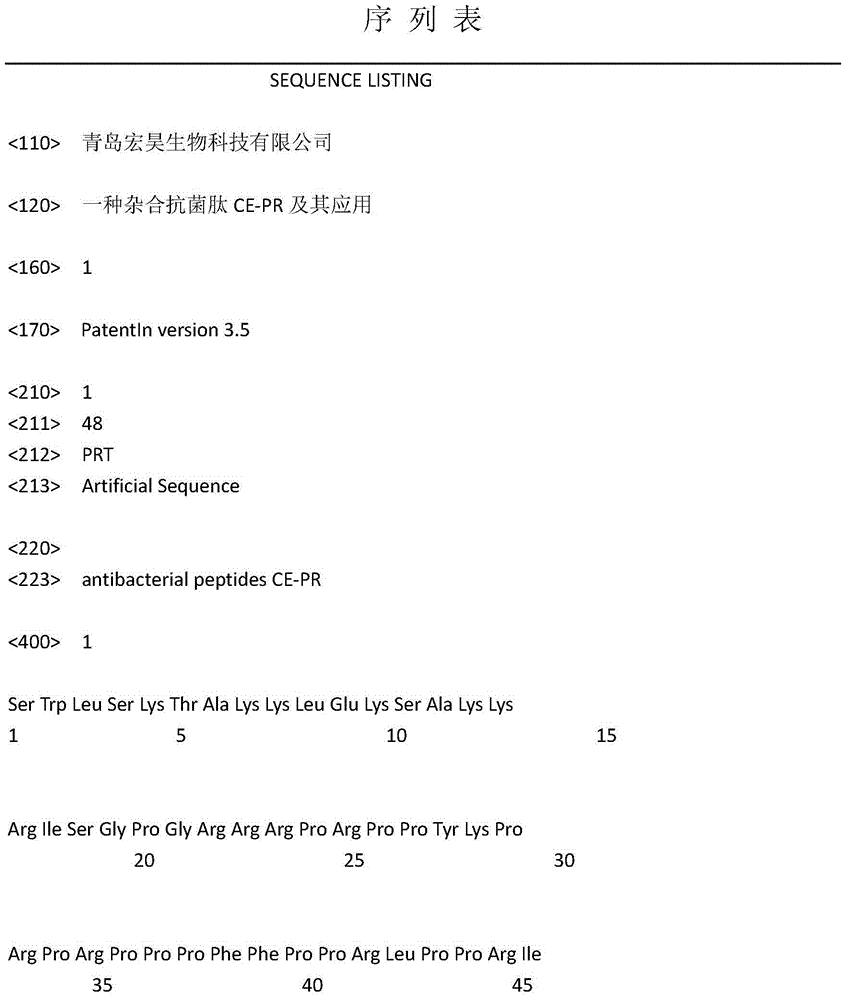Hybrid antibacterial peptide CE-PR and application thereof
A CE-PR, hybrid antimicrobial peptide technology, applied in the field of peptide screening, can solve the problem of eukaryotic cell toxicity
- Summary
- Abstract
- Description
- Claims
- Application Information
AI Technical Summary
Problems solved by technology
Method used
Image
Examples
Embodiment 1
[0013] Embodiment 1 The acquisition of hybrid antimicrobial peptide CE-PR and its gene
[0014] 1. Use biological software to analyze the spatial structure of the amino acid sequences of porcine antimicrobial peptide cecropin P1 (GenBank accession number: AB186032) and antimicrobial peptide PR-39 (GenBank accession number: NM_214450.1), and select the N-terminal of antibacterial peptide cecropin P1 Based on 19 amino acids with an α-helical structure, the 12th hydrophobic amino acid was replaced with a hydrophilic amino acid lysine (K12N), and then combined with the N-terminal 26 with strong antibacterial activity of the antibacterial peptide PR-39 amino acids were spliced, and protein Lingker (GPG) was added in the middle to obtain a novel hybrid antimicrobial peptide CE-PR, whose amino acid sequence is SEQ ID NO:1.
[0015] 2. According to the amino acid sequence SEQ ID NO: 1 of the obtained novel hybrid antimicrobial peptide CE-PR, redesign according to the codon preference ...
Embodiment 2
[0016] Example 2 Construction of Genetic Engineering Hybrid Antimicrobial Peptide CE-PR Expression Vector and Acquisition of Engineering Bacteria
[0017] 1. Both the vector containing the antimicrobial peptide gene and the yeast expression vector were digested with XhoI and XbaI, and the digested products were recovered and ligated for PCR identification and sequencing.
[0018] 2. After the positive plasmid was linearized by SacI single enzyme digestion, it was added to the competent cell suspension of Pichia pastoris. After electroporation, spread evenly on YPDS selection plate containing 100 μg / mL Zeocin, and incubate at 30°C for 3-5 days. When the positive transformants on the YPDS plate grow larger, each transformant is inoculated onto the YPDS selection plate containing Zeocin 200 μg / mL, 500 μg / mL, and 1000 μg / mL in turn, and the colonies that grow normally on the high-concentration Zeocin plate are Possibly high copy recombinant strains.
[0019] 3. Inoculate a singl...
Embodiment 3
[0020] Embodiment 3 Fermentation, the preparation of purification novel hybrid antimicrobial peptide CE-PR
[0021] 1. Fermentation process
[0022] 1) Inoculate the positive recombinants obtained by screening into Erlenmeyer flasks with 1%-10% inoculum volume after activation, and inoculate 10L with 5%-20% inoculation volume at 28-30°C and 200r / min shaker for 16-24h Fermentation tank (installed culture medium 6L), temperature 28-30 ℃, rotation speed 500-1500r / min, medium pH value 5.0-6.0, ventilation volume 0.1-1.0VVM (the amount of oxygen introduced into 1L fermentation broth for 1min), dissolved Fermentation is carried out under the condition of oxygen>20%, and 50% glycerol is fed for 4 hours after culturing for 18-24 hours. When the dissolved oxygen suddenly rises to 100%, methanol is fed until the end of fermentation. The whole fermentation lasts for 48-72 hours.
[0023] 2) After the fermentation, the original tank was steam sterilized at 100°C for 10-20 minutes, discha...
PUM
 Login to View More
Login to View More Abstract
Description
Claims
Application Information
 Login to View More
Login to View More - R&D
- Intellectual Property
- Life Sciences
- Materials
- Tech Scout
- Unparalleled Data Quality
- Higher Quality Content
- 60% Fewer Hallucinations
Browse by: Latest US Patents, China's latest patents, Technical Efficacy Thesaurus, Application Domain, Technology Topic, Popular Technical Reports.
© 2025 PatSnap. All rights reserved.Legal|Privacy policy|Modern Slavery Act Transparency Statement|Sitemap|About US| Contact US: help@patsnap.com


